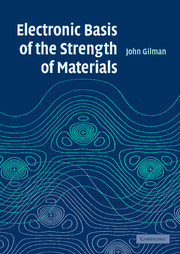Book contents
- Frontmatter
- Contents
- Preface
- Section I Introduction
- Section II Elements of solid mechanics
- Section III Elements of electron mechanics
- Section IV Elastic stiffness
- 9 Cohesion of atoms
- 10 Intramolecular cohesion
- 11 Intermolecular cohesion
- 12 Bulk modulus
- 13 Shear modulus
- 14 Entropic elasticity (polymers)
- 15 Universality and unification
- Section V Plastic strength
- Section VI Fracture resistance
- Index
- References
13 - Shear modulus
Published online by Cambridge University Press: 14 August 2009
- Frontmatter
- Contents
- Preface
- Section I Introduction
- Section II Elements of solid mechanics
- Section III Elements of electron mechanics
- Section IV Elastic stiffness
- 9 Cohesion of atoms
- 10 Intramolecular cohesion
- 11 Intermolecular cohesion
- 12 Bulk modulus
- 13 Shear modulus
- 14 Entropic elasticity (polymers)
- 15 Universality and unification
- Section V Plastic strength
- Section VI Fracture resistance
- Index
- References
Summary
General comments
Many orders of magnitude lie between the elastic response of a soft rubber (elastomer) and that of rigid diamond, more than six orders, in fact. The question for physical chemistry is: what determines the shear stiffness of a given substance? This has some sub-divisions. The two main ones are: enthalpic and entropic elasticity. This chapter discusses the first of these, and Chapter 14 discusses the latter.
The distinction between shear and dilatation is illustrated in Figure 13.1 which shows an undeformed circle at 13.1(a), the effect of shear on the circle at 13.1(b), and the effect of dilatation at 13.1(c). Note that shear does not change the area enclosed by the circle (for small deformations).
Shear moduli measure resistance to shape changes. For small shears, the volume is constant, so these moduli are conjugate to the bulk moduli which measure volume changes at constant shape.
As mentioned in Chapter 4, it was not clear until about 1887 whether one or two independent constants are needed to describe the shear responses of isotropic elastic materials (and 15 or 21 to describe trigonal crystals) (Timoshenko, 1983). In 1821, Claude Navier had proposed an atomic theory in which only central forces acted between the atoms. This related the shear and bulk moduli to one another, leaving just one independent constant for the isotropic case. Others, e.g., Stokes and Poncelet, thought that the resistance to shear was fundamentally different from the resistance to compression, so two constants were needed.
- Type
- Chapter
- Information
- Electronic Basis of the Strength of Materials , pp. 142 - 173Publisher: Cambridge University PressPrint publication year: 2003
References
- 1
- Cited by



